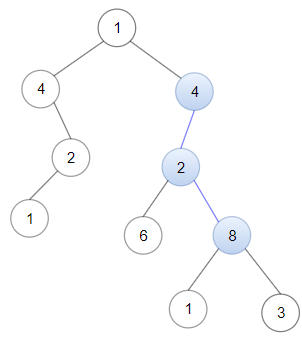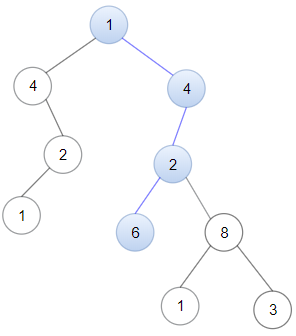Given a binary tree root and a linked list with head as the first node.
Return True if all the elements in the linked list starting from the head correspond to some downward path connected in the binary tree otherwise return False.
In this context downward path means a path that starts at some node and goes downwards.
Example 1:
Input: head = [4,2,8], root = [1,4,4,null,2,2,null,1,null,6,8,null,null,null,null,1,3] Output: true Explanation: Nodes in blue form a subpath in the binary Tree.
Example 2:
Input: head = [1,4,2,6], root = [1,4,4,null,2,2,null,1,null,6,8,null,null,null,null,1,3] Output: true
Example 3:
Input: head = [1,4,2,6,8], root = [1,4,4,null,2,2,null,1,null,6,8,null,null,null,null,1,3]
Output: false
Explanation: There is no path in the binary tree that contains all the elements of the linked list from head.
Constraints:
- The number of nodes in the tree will be in the range
[1, 2500]. - The number of nodes in the list will be in the range
[1, 100]. 1 <= Node.val <= 100for each node in the linked list and binary tree.
# Definition for singly-linked list.
# class ListNode:
# def __init__(self, val=0, next=None):
# self.val = val
# self.next = next
# Definition for a binary tree node.
# class TreeNode:
# def __init__(self, val=0, left=None, right=None):
# self.val = val
# self.left = left
# self.right = right
class Solution:
def isSubPath(self, head: ListNode, root: TreeNode) -> bool:
def dfs(head, root):
if head is None:
return True
if root is None:
return False
if root.val != head.val:
return False
return dfs(head.next, root.left) or dfs(head.next, root.right)
if root is None:
return False
return dfs(head, root) or self.isSubPath(head, root.left) or self.isSubPath(head, root.right)/**
* Definition for singly-linked list.
* public class ListNode {
* int val;
* ListNode next;
* ListNode() {}
* ListNode(int val) { this.val = val; }
* ListNode(int val, ListNode next) { this.val = val; this.next = next; }
* }
*/
/**
* Definition for a binary tree node.
* public class TreeNode {
* int val;
* TreeNode left;
* TreeNode right;
* TreeNode() {}
* TreeNode(int val) { this.val = val; }
* TreeNode(int val, TreeNode left, TreeNode right) {
* this.val = val;
* this.left = left;
* this.right = right;
* }
* }
*/
class Solution {
public boolean isSubPath(ListNode head, TreeNode root) {
if (root == null) {
return false;
}
return dfs(head, root) || isSubPath(head, root.left) || isSubPath(head, root.right);
}
private boolean dfs(ListNode head, TreeNode root) {
if (head == null) {
return true;
}
if (root == null) {
return false;
}
if (root.val != head.val) {
return false;
}
return dfs(head.next, root.left) || dfs(head.next, root.right);
}
}

